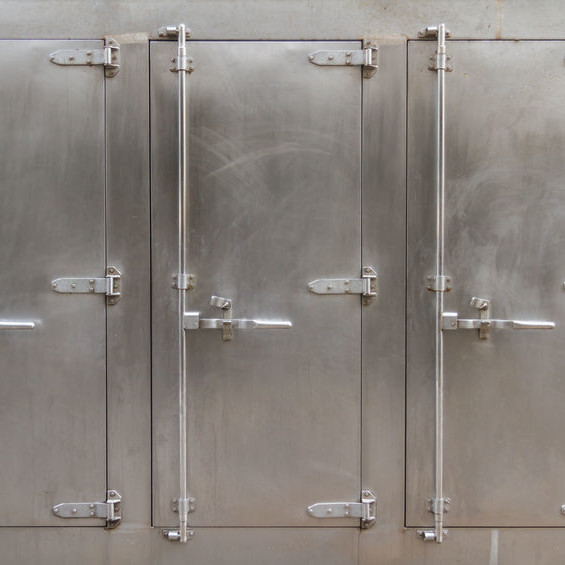
Blast Freezing
What is blast freezing?
Blast freezing is a rapid or short time thermal preservation technology commonly used in bakery and other food applications to extend the product’s shelf life and maintain its safety, physicochemical stability and freshness.
Blast freezers blow very cold air (typically at -30°C and -50°C and high flow rates of 3.0–6.0 linear meters per second) over the product to promote a faster rate of heat removal from the food products.1,2
Blast freezing of wrapped or unwrapped bread, followed by frozen storage does the following:
- Temporarily arrests starch retrogradation involved in bread firming or staling
- Prevents mold spoilage
- Ensures freshness of bakery products
It is required to prevent formation of large ice crystals within the product structure so that minimal damage occurs to the product texture.3
How does blast freezing work?
Blast freezers are available in batch or continuous modes. They require efficient compressors to force cold air over the food product until it reaches the desired temperature. To achieve blast freezing, the product must be exposed to a low-temperature for a short but sufficient time to remove its sensible and latent heat of fusion. By reducing product temperature water is converted from a liquid to solid state. To accomplish the freezing process in desired short times, a large convective heat-transfer coefficient must be created.3
Blast freezing and subsequent frozen storage can virtually stop all chemical reactions e.g., enzymatic and oxidative, metabolism, and microbiological growth, a consequence of the availability of less free water to support deteriorative reactions, and mold and bacteria growth.3
By shortening the time the bakery product spends in the critical temperature zone of 10°C to -7°C (50–20°F), where starch retrogradation rate is faster than in the crumb, there will be less firming and staling.
Application
Blast freezing of finished products and WIP helps large bakeries better prepare for unusual high demand peaks, for example, summer and U.S. national celebrations such as 4th of July, Labor Day, etc. During this preparation time, baking plants start building up inventory of dough/batter and/or baked bread without worrying about their shelf life, in an effort to buffer or balance the large temporary outflow of stock (negative balance from an inventory standpoint).
Blast freezing of baked goods
Blast freezing of finished bakery products such as bread and rolls is followed by frozen storage and a thawing step, which can be natural or mechanically forced, to bring the product to ambient temperature for retail sale. The frozen storage allows the products to be transported through large distances and maintain excellent keeping quality.
Blast freezing of doughs/batters
Blast freezing of doughs/batters aims to preserve them for extended periods of time—usually during transportation and storage—until they can be processed (proofed and baked) by an external retail or in-store bakery. The frozen dough market is becoming a very important business segment within the baking industry. Bakeries often benefit from frozen doughs because they don’t have to invest in a complete production line. Plus, the cycle time is reduced to baking and packaging times.
Important considerations when freezing doughs and baked goods include:4,5
- Keeping or maintaining the yeast vitality (fermentation capacity) after thawing and normal processing operations at the bakery. Exposure of yeast to extremely low temperatures leads to cell stress and death in a portion of the yeast population. Therefore, higher yeast proportions are recommended in frozen dough formulations to compensate for the activity loss and to retain normal gas production capacity.
- Preventing the dough from becoming too slack or weak due to internal structure damage from ice crystals via incorporation of emulsifiers such as diacetyl tartaric acid esters of mono- and di-glycerides and sucrose esters as stale inhibitors.
- As a colligative property, high concentrations of solutes such as sugars, salt and fats, depress the freezing point of doughs, thus the need for longer freezing times and/or more energy consumption to lower product temperature. Rich formulas may require different process conditions than lean formulas.
References
- Fellows, P.J. “Freezing.” Food Processing Technology: Principles and Practice, 4th edition, Woodhead Publishing, Elsevier Ltd., 2017, pp. 885–928.
- James, S.J., and James, C. “Chilling and Freezing of Foods.” Food Processing: Principles and Applications, 2nd edition, John Wiley & Sons, Ltd, 2014, pp. 79–103.
- Singh, R.P., and Heldman, D.R. “Food Freezing.” Introduction to Food Engineering, 4th edition, Academic Press, Elsevier Inc., 2009, pp. 501–539.
- Añón, M.C., Bail, A.L., and Leon, A.E. “Effect of Freezing on Dough Ingredients.” Handbook of Frozen Foods, Marcel Dekker, Inc., 2004, pp. 566–575.
- Damodaran, S. “Water and Ice Relations in Foods.” Fennema’s Food Chemistry, 5th edition, Taylor & Francis Group, LLC, 2017, pp. 19–90.

